History of the Jews in Italy
| Part of a series on |
| Jews and Judaism |
|---|
| History of Italy |
|---|
 |
|
|
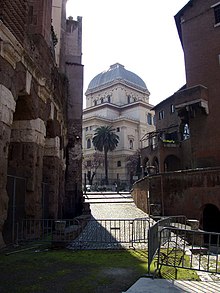
The history of the Jews in Italy spans more than two thousand years to the present. The Jewish presence in Italy dates to the pre-Christian Roman period and has continued, despite periods of extreme persecution and expulsions, until the present. As of 2019, the estimated core Jewish population in Italy numbers around 45,000.[1]
Pre-Christian Rome
The Jewish community in Rome is likely one of the oldest continuous Jewish communities in the world, existing from classical times until today.[2]
Most certainly, it is known that in 139 BCE,
Large numbers of Jews even lived in Rome during the late
The
In Rome, the community was highly organized, and presided over by heads called άρχοντες (archontes) or γερουσιάρχοι (gerousiarchoi). The Jews maintained in Rome several synagogues, whose spiritual leader was called αρχισυνάγωγος (archisynagogos). Their tombstones, mostly in
Some scholars have previously argued that Jews in the pre-Christian
The fate of Jews in Rome and Italy fluctuated, with partial expulsions being carried out under the emperors
In addition to Rome, there were a significant number of Jewish communities in southern Italy during this period. For example, the regions of Sicily, Calabria, and Apulia had well established Jewish populations.[12]
Late antiquity
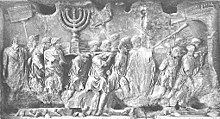
With the promotion of Christianity as a legal religion of the Roman Empire by
At the time of the foundation of the
Middle Ages
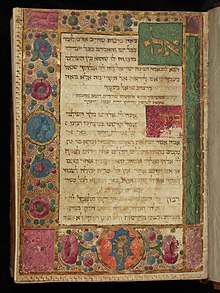
There were several expulsions, including a brief one from
Literary achievement
Among the early Jews of Italy who left written manuscripts was Shabbethai Donnolo (died 982). Two centuries later (1150), poets Shabbethai ben Moses of Rome; his son Jehiel Kalonymus, once regarded as a Talmudic authority even beyond Italy; and Rabbi Jehiel of the Mansi (Anaw) family, also of Rome, became known for their works. Nathan, son of the above-mentioned Rabbi Jehiel, was the author of a Talmudic lexicon ("'Aruk") that became the key to the study of the Talmud.
During his residence at
Toward the second half of the 13th century, signs appeared of a better Hebrew culture and of a more profound study of the Talmud.
During this period, the
The rise of
Worsening conditions under Innocent III

The position of Jews in Italy worsened considerably under Pope
Antipope Benedict XIII
The Jews suffered much from the relentless persecutions of the
The Jews were also successful as skilled medical practitioners. William of Portaleone, physician to King Ferdinand I of Naples, and to the ducal houses of Sforza and Gonzaga, was one of the ablest of that time. He was the first of the long line of illustrious physicians in his family.
Early modern period
It is estimated that in 1492 Jews made up between 3% and 6% of the population of Sicily.[15] Many Sicilian Jews first went to Calabria, which already had a Jewish community since the 4th century. In 1524 Jews were expelled from Calabria, and in 1540 from the entire Kingdom of Naples, as all these areas fell under Spanish rule and were subject to the edict of expulsion by the Spanish Inquisition.
Throughout the 16th century, Jews gradually moved from the south of Italy to the north, with conditions worsening for Jews in Rome after 1556 and the Venetian Republic in the 1580s. Many Jews from Venice and the surrounding area migrated to the Polish–Lithuanian Commonwealth at this time.[15][16][17][18]
Refugees from Spain
When Jews were
Popes
The popes and many of the most influential
Expulsion from Naples
The ultra-Catholic party tried with all the means at its disposal to introduce the Inquisition into the Neapolitan realm, then under Spanish rule. Charles V, upon his return from his victories in Africa, was on the point of exiling the Jews from Naples when Benvenida, wife of Samuel Abravanel, caused him to defer the action. A few years later, in 1533, a similar decree was proclaimed, but upon this occasion also Samuel Abravanel and others were able through their influence to avert for several years the execution of the edict. Many Jews repaired to the Ottoman Empire, some to Ancona, and still others to Ferrara, where they were received graciously by Duke Ercole II.
After the death of Pope
Although the return to Judaism of the Marrano Usques caused much rejoicing among the Italian Jews, this was counterbalanced by the deep grief into which they were plunged by the conversion to Christianity of two grandsons of
Paul IV
Marcellus' successor,
Cum nimis absurdum limited each ghetto in the Papal States to one synagogue. In the early 16th century, there were at least seven synagogues across Rome, each serving as the house of worship for distinct demographic subgroup: Roman Jews (Benè Romì), Sicilian Jews, Italian Jews (that were neither Benè Romì nor Sicilian), German Ashkenazim, French Provençal, Castilian Sephardim, and Catalan Sephardim.[20]
Many Jews abandoned Rome and Ancona and went to Ferrara and
Expulsion from Papal States
Paul IV was followed by the tolerant pope
Approval within the Republic of Venice
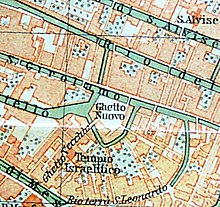
A great sensation was caused in Italy by the choice of a prominent Jew,
Persecutions and confiscations
The position of the Jews of Italy at this time was pitiable; pope Paul IV and Pius V reduced them to the utmost humiliation and had materially diminished their numbers. In southern Italy there were almost none left; in each of the important communities of Rome, Venice, and Mantua there were about 2,000 Jews; while in all
Varied fortunes
Under the following pope,
Giuseppe Ciante (d. 1670),[21] a leading Hebrew expert of his day and professor of theology and philosophy at the College of Saint Thomas in Rome was appointed in 1640 by Pope Urban VIII to the mission of preaching to the Jews of Rome (Predicatore degli Ebrei) in order to promote their conversion." In the mid-1650s Ciantes wrote a "monumental bilingual edition of the first three Parts of Thomas Aquinas' Summa contra Gentiles, which includes the original Latin text and a Hebrew translation prepared by Ciantes, assisted by Jewish apostates, the Summa divi Thomae Aquinatis ordinis praedicatorum Contra Gentiles quam Hebraicè eloquitur.... Until the present this remains the only significant translation of a major Latin scholastic work in modern Hebrew."[22]
In the ducal dominions
It was strange that under
The Mantuan Jews suffered seriously at the time of the
The victories in Europe of the Turks, who brought their armies up to the very walls of Vienna in a 1683 siege, helped even in Italy to incite the Christian population against the Jews, who remained friendly to the Ottoman Empire. In Padua, in 1683, the Jews were in great danger because of the agitation fomented against them by the cloth-weavers. A violent tumult broke out; the lives of the Jews were seriously menaced; and it was only with the greatest difficulty that the governor of the city succeeded in rescuing them, in obedience to a rigorous order from Venice. For several days thereafter the ghetto had to be especially guarded.
Reaction after Napoleon

Among the first schools to adopt the Reform projects of
. Under the influence of the liberal religious policy of Napoleon I, the Jews of Italy, like those of France, were emancipated. The supreme power of the popes was broken: they no longer had time to give to framing anti-Jewish enactments, and they no longer directed canonical laws against the Jews.To the Sanhedrin convened by Napoleon at Paris (1807), Italy sent four deputies: Abraham Vita da Cologna; Isaac Benzion Segre, rabbi of Vercelli; Graziadio Neppi, physician and rabbi of Cento; and Jacob Israel Karmi, rabbi of Reggio. Of the four rabbis assigned to the committee which was to draw up the answers to the twelve questions proposed to the Assembly of Notables, two, Cologna and Segre, were Italians, and were elected respectively first and second vice-presidents of the Sanhedrin. But the liberty acquired by the Jews under Napoleon was of short duration; it disappeared with his downfall.
Pope Pius VII, on regaining possession of his realms, reinstalled the Inquisition; he deprived the Jews of every liberty and confined them again in ghettos. Such became to a greater or less extent their condition in all the states into which Italy was then divided; in Rome they were again forced to listen to proselytizing sermons.
In the year 1829, consequent upon an edict of the
Nineteenth century
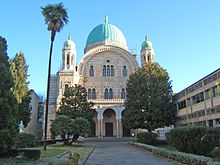
The return to medieval servitude after the Italian restoration did not last long; and the
Twentieth century
Early twentieth century
Italian prime minister Luigi Luzzatti, who took office in 1910, was one of the world's first Jewish heads of government (not converted to Christianity). Another Jew, Ernesto Nathan served as mayor of Rome from 1907 to 1913. By 1902, out of 350 senators, there were six Jews. By 1920, there were nineteen Jewish senators.
Approximately 5,000 Italian Jews were conscripted to the Royal Italian Army during World War I and about half of them served as officers (this was due to the average higher level of education among Italian Jews). About 420 were killed in action or went missing in action; about 700 received military decorations.
Jews during the Fascist era
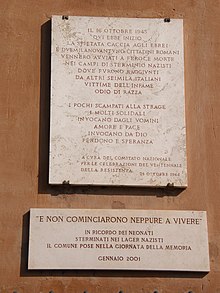
Jews fervently supported the Risorgimento, identified as Italian nationalists, proved valiant as soldiers in World War I, and, in terms of their relatively small numerical presence within the general population, they later went on to form a disproportionate part of the Fascist Party from its beginnings down to 1938.[23][24]
In 1929, Mussolini acknowledged the contributions which Italian Jews had made to Italian society, despite their minority status, and he also believed that Jewish culture was Mediterranean, aligning his early opinion of Italian Jews with his early Mediterraneanist perspective. He also argued that Jews were natives of Italy, after living on the Italian Peninsula for a long period of time.[25][26] In the early 1930s, Mussolini held discussions with Zionist leadership figures over proposals to encourage the emigration of Italian Jews to the mandate of Palestine, as Mussolini hoped that the presence of pro-Italian Jews in the region would weaken pro-British sentiment and potentially overturn the British mandate.[27]
Until
It has also been indicated that
Mussolini originally held the view that a small contingent of
Despite the presence of a Fascist regime, some Jewish refugees considered Italy a safe haven in the first half of the 1930s. During that period, the country hosted up to 11,000 persecuted Jews, including 2,806 Jews who were of German descent.
The anti-Semitic metamorphosis of Fascism culminated in the
At least until the promulgation of the 1938 racial laws, a number of Italian Jews were sympathetic to the regime and occupied significant offices and positions in politics and economy. It is estimated that 230 Italian Jews participated in the October 1922 March on Rome that brought about Mussolini's ascent to power. The 1938 Italian census recorded 590 Jewish "old fighters" who had joined the National Fascist Party before its seizure of power in 1922.[49]
Examples of Italian Jews that operated within the regime until the enactment of the racial laws include
The Fascist regime also helped, at the request of
The Italian colonial authorities in Ethiopia after the conquest of this African state came into contact with the Beta Israel community and greatly favoured them, enacting special laws to protect them from offences and violences routinely committed against them by Christian and Muslim Ethiopians. The regime also encouraged cultural exchanges between the Italian Jewish community and the Ethiopian Jews. Incidentally, the first scholar to describe using a modern, scientific approach this ethnic group had been Filosseno Luzzatto, an Italki Jew. Starting in 1843, he collected and selected data about the Falasha.
On 28 July 1938, Pope
In September of that year in a speech to Belgian pilgrims, Pius XI proclaimed:
Mark well that in the Catholic Mass, Abraham is our Patriarch and forefather. Anti-Semitism is incompatible with the lofty thought which that fact expresses. It is a movement with which we Christians can have nothing to do. No, no I say to you it is impossible for a Christian to take part in anti-Semitism. It is inadmissible. Through Christ and in Christ we are the spiritual progeny of Abraham. Spiritually we are all Semites.
While some Catholic prelates tried to find compromises with Fascism, several others spoke out against racism.
After Italy entered the war in 1940, Jewish refugees living in Italy were interned in
The deportations of Italian Jews to Nazi
The attitude of the Italian Fascists (in their Italian Social Republic German puppet state in northern Italy) towards Italian Jews drastically changed in November 1943, after the Fascist authorities declared them to be of "enemy nationality" during the
After September 1943, when the Italian northern half effectively came under German occupation, SS-
The security police and the
General Kurt Mälzer, the German commander in Rome, died in 1952. The Austrian Ludwig Koch was the head of the Gestapo and the Fascist Italian police in Rome and received three years imprisonment after the war.[62]
Jews after the war
It is estimated that about 10,000 Italian Jews were deported to concentration and death camps, of whom 7,700 perished in the Holocaust, out of a pre-war Jewish population that amounted to 58,500 (46,500 by Jewish religion and 12,000 converted or non-Jewish sons of mixed marriages).[63][64] The surviving community was able to maintain its distinctiveness throughout the following decades and continued to have a significant role in the fields of politics, literature, science and industry. Writers such as Giorgio Bassani, Natalia Ginzburg and Primo Levi were among the leading figures of the Italian culture in the post-war years.
A significant event that marked the Italian Jewish community was the conversion to Catholicism of the Chief Rabbi of Rome, Israel Zolli, in 1945.
The size of the Italian Jewish community has faced a slight but continuous drop throughout the postwar decades, partly because of
21st century
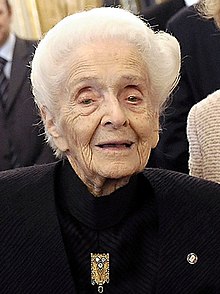
In 2007 the Jewish population in Italy numbered around 45–46,000 people, decreased to 42,850 in 2015 (36,150 with
Demographics
In 2007, there were approximately 45,000 Jews in Italy, of a total Italian population of 60 million people (i.e., 0.05-0.1% of the total), not counting recent migrations from Eastern Europe. The greatest concentrations were in Rome (20,000 people) and Milan (12,000 people).
See also
History of the Jews in Italy by region
- History of the Jews in Apulia
- History of the Jews in Calabria
- History of the Jews in Florence
- History of the Jews in Livorno
- History of the Jews in Naples
- History of the Jews in Sardinia
- History of the Jews in Sicily
- History of the Jews in Trieste
- History of the Jews in Turin
- History of the Jews in Venice
Other
- History of the Jews in the Roman Empire
- Expulsion of the Jews from Sicily
- Religion in Italy
- Roman Ghetto
- Venetian Ghetto
- List of Italian Jews
- List of Italian locations of Jewish history
- List of Italian religious minority politicians
- Bologna Guild of Silk Weavers A Jewish guild of silk weavers who endeavored in Hebrew fine printing (1537-1540).
- Senigaglia family A very old Italian Jewish family that can be traced back over 800 years.
References
- Bar/Bat Mitzvah etc.). Excluded are therefore "ethnic Jews", lay Jews, atheist/agnostic Jews, et al. – cfr. "Who is a Jew?". If these are added, then the total population would increase, possibly to approx. 45,000 Jews in Italy, not counting recent migrations from North Africa and Eastern Europe.
- ^ "The Jewish Community of Rome". The Museum of the Jewish People at Beit Hatfutsot.
- ^ 1 Maccabees 14: 24: "After this Simon sent Numenius to Rome with a large gold shield weighing a thousand minas, to confirm the alliance with the Romans."
- ^ Philo of Alexandria, with Charles Duke Yonge, trans., The works of Philo Judaeus, the contemporary of Josephus (London, England: Henry G. Bohn, 1855), vol. 4, "A treatise on the virtues and on the office of ambassadors. Addressed to Caius.", p. 134. From p. 134: "How then did he [i.e., the emperor Caligula] look upon the great division of Rome which is on the other side of the river Tiber, which he was well aware was occupied and inhabited by the Jews? And they were mostly Roman citizens, having been emancipated; for, having been brought as captives into Italy, they were manumitted by those who had bought them for slaves, without ever having been compelled to alter any of their heredity or national observances."
- ^ However, the Roman author Valerius Maximus in Book 1, Chapter 3, § 3 of his book Factorum ac dictorum memorabilium libri IX (Nine books of memorable deeds and sayings), states that during the consulship of Marcus Popillius Laenas and Gnaeus Calpurnius (c. 139 BC), the praetor Gnaeus Cornelius Hispanus expelled the Jews from Rome because they had tried to spread their religion among the Romans. See:
- Valerius Maximus, with Carl Halm, ed., Factorum et dictorum memorabilium libri novem (Leipzig, (Germany): Teubner, 1865), p. 17. (in Latin)
- Valerius Maximus with Henry John Walker, trans., Memorable Deeds and Sayings: One Thousand Tales from Ancient Rome (Indianapolis, Indiana, U.S.: Hackett Publishing Co., 2004), p. 14.
- ^ https://www.jewishvirtuallibrary.org/jsource/judaica/ejud_0002_0011_0_10485.html; Suetonius, Divus Iulius, 84 (http://penelope.uchicago.edu/Thayer/E/Roman/Texts/Suetonius/12Caesars/Julius*.html#34)
- ^ McGing, Brian: Population and proselytism: how many Jews were there in the ancient world?., in Bartlett, John R. (ed.): Jews in the Hellenistic and Roman Cities. Routledge, 2002.
- ^ Gruen, Erich S.: Diaspora: Jews amidst Greeks and Romans, p. 46. Harvard University Press, 2004.
- ^ The expulsion of the Jews from Rome by the emperor Tiberius is mentioned in:
- Josephus Flavius, with William Whiston, trans., The Genuine Works of Flavius Josephus (New York, New York: Robinson, Pratt & Co., 1841), vol. 4, The Antiquities of the Jews: Book 18, Chapter 3, § 5, p. 68. From p. 68: "There was a man who was a Jew, but had been driven away from his own country by an accusation laid against him for transgressing their laws, and by the fear he was under of punishment for the same; but in all respects a wicked man. He, then living at Rome, professed to instruct men in the wisdom of the laws of Moses. He procured also three other men, entirely of the same character with himself, to be his partners. These men persuaded Fulvia, a woman of great dignity, and one that had embraced the Jewish religion, to send purple and gold to the temple at Jerusalem; and when they had gotten them, they employed them for their own uses, and spent the money themselves, on which account it was that they at first required it of her. Whereupon Tiberius, who had been informed of the thing by Saturninus, the husband of Fulvia, who desired inquiry might be made about it, ordered all of the Jews to be banished out of Rome; at which time the consuls listed four thousand men out of them, and sent them to the island of Sardinia; but punished a greater number of them, who were unwilling to become soldiers, on account of keeping the laws of their forefathers. Thus were the Jews banished out of the city by the wickedness of four men."
- Cornelius Tacitus, The Annals (Philadelphia, Pennsylvania, U.S.: David McKay, 1897), Book 2, § 85, pp. 122–123. From pp. 122–123: "Measures were also taken for exterminating the solemnities of the Jews and the Egyptians; and a decree of the senate was passed, that four thousand descendants of franchised slaves, defiled with that superstition, and of age to carry arms, should be deported to Sardinia, to check the practice of freebootery there; and if, through the malignity of the climate, they perished, it would be small loss; that the rest should depart Italy, unless by a stated day they had renounced their profane rites."
- Suetonius, The Lives of the Twelve Caesars (New York, New York: The Modern Library, 1931), § 36, p. 142. From p. 142: "He [i.e., the emperor Tiberius] abolished foreign cults, especially the Egyptian and the Jewish rites, compelling all who were addicted to such superstitions to burn their religious vestments and all their paraphernalia. Those of the Jews who were of military age he assigned to provinces of less healthy climate, ostensibly to serve in the army. Others of the same race or of similar beliefs he banished from the city, on pain of slavery for life if they did not obey."
- Cassius Dio with Earnest Cary, trans., Dio's Roman History (London, England: William Heinemann Ltd., 1968), vol. 7, Book 57, Ch. 18, line 5a, p. 163. From p. 163: "As the Jews had flocked to Rome in great numbers and were converting many of the natives to their ways, he [i.e., the emperor Tiberius] banished most of them."
- Smallwood, E. Mary (1956). "Some notes on the Jews under Tiberius". Latomus. 15: 314–329.
- ^ The expulsion of the Jews from Rome by the emperor Claudius is mentioned in:
- Acts 18:1–3: "After this, Paul left Athens and went to Corinth. There he met a Jew named Aquila, a native of Pontus, who had recently come from Italy with his wife Priscilla, because Claudius had ordered all Jews to leave Rome. Paul went to see them, and because he was a tentmaker as they were, he stayed and worked with them."
- Suetonius, The Lives of the Twelve Caesars (New York, New York: The Modern Library, 1931), §25, p. 227. From p. 227: "Since the Jews constantly made disturbances at the instigation of Chrestus, he [i.e., the emperor Claudius] expelled them from Rome."
- However, Cassius Dio states that Claudius did not expel all of the Jews from Rome. Cassius Dio with Earnest Cary, trans., Dio's Roman History (London, England: William Heinemann Ltd., 1968), vol. 7, Book 60, Ch. 6, lines 6–7, p. 383. From p. 383: "As for the Jews, who had again increased so greatly that by reason of their multitude it would have been hard without raising a tumult to bar them from the city, he did not drive them out, but ordered them, while continuing their traditional mode of life, not to hold meetings."
- See also Wikipedia's article: Claudius' expulsion of Jews from Rome.
- ^ "Greece-Italy and the Mediterranean Islands". Jewish Web Index. Archived from the original on 14 March 2012.
- JSTOR 41284397.
- ^ "Prima giudecca di Trani". Retrieved 15 December 2022.
- ^ a b Talalay Dardashti, Schelly (20 August 2006). "Tracing the Tribe: At the ICJG: Jews in Italy". Retrieved 19 September 2007.
- ^ Singer, Isidore (1906). "Rapoport". Jewish Encyclopedia. Retrieved 16 September 2007.
- ^ Kayserling, Meyer; Gotthard Deutsch, M. Seligsohn, Peter Wiernik, N.T. London, Solomon Schechter, Henry Malter, Herman Rosenthal, Joseph Jacobs (1906). "Katzenellenbogen". Jewish Encyclopedia. Retrieved 16 September 2007.
{{cite encyclopedia}}: CS1 maint: multiple names: authors list (link) - ISBN 0-8063-1741-8.
- ^ James Carroll, Constantine's Sword, Boston, Houghton Mifflin, 2002, pp. 363–64.
- ISBN 9781317320319.
- ^ Galletti in Vat. Lat. 7900 f. 106; Hierarchia Catholica Medii Aevi, Vol 4, 233, https://www.scribd.com/doc/63478112/Hierarchia-Catholica-Medii-Aevi-V4 Accessed 21 February 2013.
- ^ "Kabbalah and Conversion: Caramuel and Ciantes on Kabbalah as a Means for the Conversion of the Jews", by Yossef Schwartz, in Un'altra modernità. Juan Caramuel Lobkowitz (1606–1682): enciclopedia e probabilismo, eds. Daniele Sabaino and Paolo C. Pissavino (Pisa: Edizioni EPS 2012): 175–187, 176–7, https://www.academia.edu/2353870/Kabbalah_and_Conversion_Caramuel_and_Ciantes_on_Kabbalah_as_a_Means_for_the_Conversion_of_the_Jews Accessed 16 March 2012. See Summa divi Thomae Aquinatis ordinis praedicatorum Contra Gentiles quam Hebraicè eloquitur Iosephus Ciantes Romanus Episcopus Marsicensis ex eodem Ordine assumptus, ex typographia Iacobi Phaei Andreae filii, Romae 1657.
- ^ Stanley G. Payne, A History of Fascism, 1914–1945 , University of Wisconsin Press, 1996 pp.239-240.
- ^ R. J. B. Bosworth,Mussolini, Bloomsbury Publishing, Rev.ed. 2014 pp.123f.
- ISBN 978-9004212558. Retrieved 9 January 2016.
- ^ Neocleous, Mark. Fascism. Minneapolis, Minnesota, USA: University of Minnesota Press, 1997. p. 35
- ISBN 978-0415400695
- ISBN 978-0-521-84101-6.
- ^ Christopher Hibbert, Benito Mussolini (1975), p. 99
- ^ Zimmerman, p.160
- ^ Hibbert, p. 98
- ISBN 9788830623378.
- ^ Masera, Michele (1977). La Chiesa cattolica nella seconda guerra mondiale (in Italian). Landoni. p. 92.
- ^ Piers Brendon, The Dark Valley: A Panorama of the 1930s, Knopf Doubleday Publishing Group, 2007 pp.552f.
- ^ Salvatore Garau, Fascism and Ideology: Italy, Britain, and Norway, Routledge, 2015 pp.122-123.
- ^ John Whittam, Fascist Italy, Manchester University Press, 1995 pp.95f.
- ^ Michele Sarfatti, Anne C. Tedeschi, The Jews in Mussolini's Italy: From Equality to Persecution, University of Wisconsin Press, 2006 p.13.
- ^ David I. Kertzer, The Popes Against the Jews: The Vatican's Role in the Rise of Modern Anti-Semitism, Knopf Doubleday Publishing Group, 2007 p.266.
- ^ a b Valentina Pisanty (2006). La difesa della razza: Antologia 1938–1943. Bompiani.
- ^ Racial theories in Fascist Italy by Aaron Gilette
- ^ Dictating Demography: The Problem of Population in Fascist Italy by Carl Ipsen, pg 187
- ^ Huysseune, Michel (2006). Modernity and Secession: The Social Sciences and the Political Discourse of the Lega Nord in Italy. Berghahn Books. p. 53.
- ISBN 0-8039-4648-1. Archived from the original(PDF) on 15 May 2008.
- ^ "The Italian Holocaust: The Story of an Assimilated Jewish Community". ACJNA.org. 8 January 2008.
- ^ Benito Mussolini By Jeremy Roberts
- ^ ISBN 978-88-14-15571-0. Retrieved 9 August 2013.
- ^ ISBN 978-1-85109-439-4. Retrieved 12 August 2013.
- ISBN 978-0520071995
- ISBN 978-0-203-83744-3, retrieved 4 November 2021
- ^ a b Sergio Pagano, The Catholic Church and Racial Laws, L'Osservatore Romano. Weekly Edition in English, 14 January 2009, p.10
- ^ Hubert Wolf, Kenneth Kronenberg, "Pope and Devil: The Vatican's Archives and the Third Reich", Harvard University Press, 2010, p.91 ; See also fr:Oremus et pro perfidis Judaeis#Les années 1920 et la tentative de réforme des Amici Israel.
- ^ " È nata all'estero – disse – e serpeggia un po' dovunque una specie di eresia, che non-solamente attenta alla fondamenta soprannaturali della cattolica Chiesa, ma materializza nel sangue umano i concetti spirituali di individuo, di Nazione e di Patria, rinnega all'umanità ogni altro valore spirituale, e costituisce così un pericolo internazionale non-minore di quello dello stesso bolscevismo. È il cosiddetto razzismo ". Chiesadimilano.it, with the collaboration of Annamaria Braccini,Quando il cardinale Schuster denunciò le leggi razziali Archived 5 February 2011 at the Wayback Machine, 19 December 2008, quoting "Un'Eresia Antiromana", L'Italia, 15 November 1938, p.1
- ^ "The Jews of Italy". The Museum of the Jewish People at Beit Hatfutsot. Retrieved 25 June 2018.
- ^ Gentile, p. 15
- ISBN 9780521841016. Retrieved 21 September 2018.
- ISBN 9780253023865. Retrieved 21 September 2018.
- ^ Gentile, p. 4
- ^ Gentile, p. 5
- ^ Gentile, p. 6
- ^ "Dannecker, Theodor (1913–1945)" (in German). Gedenkorte Europa 1939–1945. Retrieved 19 September 2018.
- ^ "Boßhammer, Friedrich (1906–1972)" (in German). Gedenkorte Europa 1939–1945. Retrieved 19 September 2018.
- ^ "The Destruction of the Italian Jews The German Occupation of Europe". holocaustresearchproject.org.
- ^ "Estimated Number of Jews Killed in the Final Solution". jewishvirtuallibrary.org. Retrieved 3 April 2018.
- ^ Elizabeth Bettina, "It happened in Italy: Untold stories of how the people of Italy defied the horrors of the Holocaust", p. 26, Thomas Nelson, 2011.
- ISSN 0362-4331. Retrieved 29 April 2019.
 This article incorporates text from a publication now in the public domain: Singer, Isidore; et al., eds. (1901–1906). The Jewish Encyclopedia. New York: Funk & Wagnalls.
This article incorporates text from a publication now in the public domain: Singer, Isidore; et al., eds. (1901–1906). The Jewish Encyclopedia. New York: Funk & Wagnalls. {{cite encyclopedia}}: Missing or empty|title=(help)
Bibliography
- Bassani, Giorgio, ISBN 0-15-634570-6
- Bettina, Elizabeth, It Happened in Italy: Untold Stories of How the People of Italy Defied the Horrors of the Holocaust (Thomas Nelson Inc, 2011) ISBN 9781595551023
- Collotti, Enzo,Il Fascismo e gli ebrei. Le leggi razziali in Italia (Bari / Roma, Editori Laterza, 2003).
- D'Amico, Giovanna, Quando l'eccezione diventa norma. La reintegrazione degli ebrei nell'Italia postfascista (Torino, Bollati Boringhieri, 2005).
- Druker, Jonathan, Primo Levi and Humanism After Auschwitz – Posthumanist Reflections (Palgrave MacMillan, NY, 2009). ISBN 978-1-4039-8433-3
- Feinstein, Wiley, The Civilization of the Holocaust in Italy: Poets, Artists, Saints, Anti-Semites (Madison, NJ: Fairleigh Dickinson University Press, 2004).
- Ferrara degli Uberti, Carlotta, "Fare gli ebrei italiani. Autorappesentazioni di una minoranza (1861–1918)", (Bologna, Il Mulino 2010).
- Harrowitz, Nancy A., Anti-Semitism, Misogyny, and the Logic of Cultural Difference: Cesare Lombroso and Matilde Serao (Lincoln and London: University of Nebraska Press, 1994).
- Jäger, Gudrun / Novelli-Glaab, Liana (eds.): Judentum und Antisemitismus im modernen Italien (Berlin, 2007).
- Levi, Primo, ISBN 0-8052-0811-9(paperback)
- Marzano, Arturo / Schwarz, Guri, "Attentato alla sinagoga. Roma 9 ottobre 1982. Il conflitto israelo-palestinese e l'Italia" (Rome, Viella 2013).
- Pacifici Noja, Ugo G. / Pacifici, Giorgio eds. Ebreo chi? Sociologia degli ebrei italiani ( Jewish who? A sociology of the Italian Jews today), with contributions of Umberto Abenaim, Massimiliano Boni, Angelica Edna Calo Livne, Enzo Campelli, Renata Conforty Orvieto, Sergio Della Pergola, Natan Orvieto, Rossana Ottolenghi, Giorgio Pacifici, Ugo G. Pacifici Noja, Vittorio Pavoncello, Gian Stefano Spoto, Claudio Vercelli, with a foreword of Furio Colombo, Jaca Book, Milan, 2017 ISBN 978-88-16-41419-8
- Pavan, Ilaria, Il podestà ebreo. La storia di Renzo Ravenna tra fascismo e leggi razziali (Bari / Roma, Editori Laterza, 2006).
- Pavan, Ilaria, Tra indifferenza e oblio. Le conseguenze economiche delle leggi razziali in Italia 1938–1970 (Firenze, 2004).
- Pavan, Ilaria / Schwarz, Guri (a cura di), Gli ebrei in Italia tra persecuzione fascista e reintegrazione postbellica (Firenze, 2001).
- Sarfatti, Michele, Gli Ebrei nell'Italia fascista. Vicende, identità, persecuzione (Torino, 2000).
- Sarfatti, Michele, The Jews in Mussolini's Italy: From Equality to Persecution (Madison, University of Wisconsin Press, 2006) (Series in Modern European Cultural and Intellectual History).
- Schwarz, Guri, After Mussolini: Jewish Life and Jewish Memories in Post-Fascist Italy (London-Portland, OR: Vallentine Mitchell, 2012).
- Schächter, Elizabeth, "The Enigma of Svevo's Jewishness: Trieste and the Jewish Cultural Tradition," Italian Studies, 50 (1995), 24–47.
- Segre, Dan Vittorio, Memoirs of a Fortunate Jew: An Italian Story (Chicago, University of Chicago Press, 2008).
- Zimmerman, Joshua D. (ed), The Jews of Italy under Fascist and Nazi Rule 1922–1945 (Cambridge, CUP, 2005).
- Zuccotti, Susan, The Italians and the Holocaust – Persecution, Rescue, Survival (Basic Books, NY, 1987) ISBN 0465-03622-8
External links
- Fascist Italy and the Jews: Myth versus Reality an online lecture by Dr. Iael Nidam-Orvieto of Yad Vashem
- The Jewish History of Rome Rabbi Menachem Levine, Aish.com
- Listing of all Jewish synagogues, schools, restaurants, etc... in Italy
- Italy's Jews survive, even thrive, despite problems with high intermarriage rate 19 November 1999
- Italy and the Jews – Timeline Jewish Virtual Library
- Chabad-Lubavitch Centers in Italy

